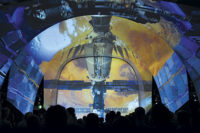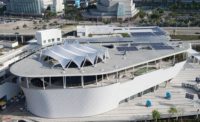The Marriage of Form & Function

Photos courtesy of Radius Track.
From the outside, the newly opened New World Center, the campus of the elite New World Symphony in Miami Beach, Fla., may not appear to be a celebration of curves. But visitors stepping inside the rectangular 80-foot high glass box are treated to a dynamic interior full of dramatic swoops, swirls and sails designed by Gehry Partners. Indeed, Gehry’s vision for the project called for curves in almost every space of the 106,350-square-foot building. Radius Track, provider of cold formed steel framing and 3-D modeling for curved surfaces, was called in to transform Gehry’s architectural concepts into engineering reality.

Tuning Up
New World Symphony, the noted orchestral academy, prepares highly gifted graduates of distinguished music programs for leadership roles in orchestras and ensembles around the world. With the opening of the innovative New World Center campus, students now have access to some of the orchestral world’s premier performance spaces and learning environments.In eras past, a design with these curved surfaces and dramatic knife edges would have been nearly impossible to complete. There are simply too many complex curves and 3-D objects with no “plumb-bob-angle” surface to set as a work point. However, advances in curved cold formed steel framing and BIM 3-D modeling allowed the curves not only to be relatively quickly and easily built, but to be precise enough to acoustically tune the building’s world-class concert halls.
The first glimpse of Gehry’s distinctive curved design comes in an overhanging portico that encompasses Gehry’s signature scalloped sails. Inside, a soaring 80-foot glass wall leads into an atrium featuring a high-tech box office, a public bar with an undulating canopy and a series of playful geometric practice and rehearsal rooms. These unique rooms are essentially a series of stacked forms, contorted, compressed and twisted to fit within the rectangular building structure.
The centerpiece of the building is a 757-seat natural acoustic performance space featuring large, distinctive sail-like acoustical surfaces designed for the ultimate orchestral experience. A director’s studio and penthouse garden sit atop the structure.

Creating the Curves
Radius Track worked closely with the project’s structural engineers, Haskel Mayer, PE (Mayer Structural Design in Miami) and Gilsanz, Murray, Steficek LLP (New York) to create the intricate framing necessary for the project.“This was one of the most challenging projects in company history due to the abstract and unbalanced nature of the forms that exist in the space,” says Radius Track President Bob Krebsbach. “Because many of the surfaces are angled, tipped or curved, traditional framing methods would not have been cost effective. The framing members had to be perfectly fabricated with incredible precision. When you are creating surfaces like these, every piece is different.”
The architectural team created 3-D models of the surfaces themselves and handed them off to the curved steel framing fabricator (Radius Track). The curved framing team took the curved surfaces and began creating “framing solids” (the spaces assigned to the eventual built framing members) based on requirements set forth by the structural engineering team.
Next, each curved surface was individually analyzed to optimize the curved surface and ensure that each one precisely matched the architect’s design intent. Then, the isoparms (the lines that define the surface) were positioned to optimize framing efficiency. These isoparms became the “wires” (the bent corners between flange and web on the outside of the framing solid surface) which served as the basis for calibrating the curvature and bend spacing of the framing members. Proprietary modeling software then compiled all of this information and organized it into bend spacing and bend angle settings for each unique piece of the framing system.

The Right Tools
Each piece of the framing puzzle was then pre-bent to exacting standards (1/8 inch per 10 feet) at the fabrication facility using proprietary pneumatic and hydraulic benders. This is a drastically different method than was used even a few years ago. Prior to the advent of these new bending tools, many structural steel curves were created using a process called stretch forming. In this method, steel members are bent around custom-built forms using large-capacity hydraulic stretching equipment. Although effective, this method requires custom forms to be built for each curve in the framing system, significantly increasing costs while limiting the number of curves that are included in the project.In the late-1990s, Radius Track introduced proprietary bending tools. These tools use calibrated crimps (or bends) in the web and/or flange of standard steel tracks and steel studs to precisely curve members to match design intent. Because no molds are required to bend the members, this method is both more versatile and more affordable. Today, these tools have been integrated into complex computer systems, allowing even heavier gauge members to be bent into precise curves and even compound curves. This was certainly the case for the New World Center. As the curved members were created, each piece was double-checked for accuracy on a layout table to ensure complete precision.
Knife Edges
Interestingly, the curves did not end up being the biggest challenge on this job. Gehry’s design called for knife edges throughout the project. Knife edges come together at a sharp edge or acute angle. These have been among the most challenging profiles for drywall contractors to execute consistently and precisely. They can be difficult enough to execute when they are uniform from top to bottom. However, in New World Center, the angles were constantly changing as they went from floor to ceiling along the curved surfaces.In most cases, to create a knife edge, framing members are welded to give the edge an added rigidity. However, the dynamic curves in this design meant that welding was not an option. Even a single weld bead would have warped the shape of the geometrically precise forms. The challenge for Radius Track was to devise a way to create the stiffness that drywall contractors would need in order to execute the knife edges flawlessly.
The custom solution came in the form of diagonally-braced frames. A unique tie system holds the members together, allowing the creation of a smooth, sharp knife edge.

Trial Run
Due to the complexity of the curves and the knife edge support system, the construction contract required large mockups to be created of many of the complicated structural forms in a nearby Miami warehouse. The entire assembly was tested at the warehouse with all trades participating. The curved framing components, combined with the tie system, were able to effectively and accurately create the curves specified in Gehry’s original design.In all, Radius Track created an Erector Set-type kit of parts containing 259 different surfaces, for a total of 505,683 square feet installed and covered with drywall. The company created nearly 3,500 studs and more than 2,500 tracks, 94 percent of which are one-of-a-kind.
Finishing Touches
Radius Track partnered with the Miami offices of specialty contractor Lotspeich Co. Inc. to finalize the wall surfaces. “This project was a completely new way of building for us,” recalls Lotspeich Senior Project Manager and Vice President Joaquin Riera. “We’d never worked on a project that had so many undulating, curved surfaces and the knife edges. Understanding complex 3-D modeling and using Rhino was new to some of our job site team, and they were a bit nervous at the beginning of the project. However, as time progressed they realized that these models actually made their job simpler. Radius Track fabricated the complicated knife edges in Minneapolis, and then shipped them to us in an incredibly organized way. Looking back on the project, it would have been impossible to do without Radius Track.”With the framing complete, Lotspeich was able to complete the acoustic drywall quickly and efficiently. With geometrically precise surfaces, the drywall portion of the job was made easier and more efficient.
Classical Music for the Masses
Several months after the building’s opening, people who have never experienced classical music are flocking to the New World Center. The design of the building is the perfect marriage of form and function-a classical musical tradition set against an arrestingly beautiful bevy of curves. The symphony extends itself to the public through live feed performances played on the side of the building for pedestrians to enjoy. During the day, when no performances are going on, visitors can peer into the rehearsal halls and wander through the symphony lobby. The new building also offers audience members the opportunity to observe performers from a balcony as they prepare to play.As a structural landscape based on fluid lines, the New World Center gestures toward a more accessible take on classical music in the modern era. It blends the lines between high-art aficionados and invigorates and those who see classical music as an antiquated genre. The brilliant, sweeping curves of the New World Symphony define classical music’s new home as a place where edge and elegance meet. With dynamic spaces that dive, loop and dance, Gehry’s curved masterpiece takes a bow before some of the loveliest sounds on earth.
Looking for a reprint of this article?
From high-res PDFs to custom plaques, order your copy today!








